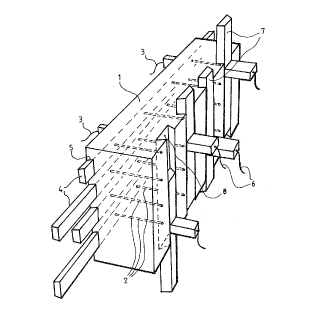Une partie des informations de ce site Web a été fournie par des sources externes. Le gouvernement du Canada n'assume aucune responsabilité concernant la précision, l'actualité ou la fiabilité des informations fournies par les sources externes. Les utilisateurs qui désirent employer cette information devraient consulter directement la source des informations. Le contenu fourni par les sources externes n'est pas assujetti aux exigences sur les langues officielles, la protection des renseignements personnels et l'accessibilité.
L'apparition de différences dans le texte et l'image des Revendications et de l'Abrégé dépend du moment auquel le document est publié. Les textes des Revendications et de l'Abrégé sont affichés :
| (12) Brevet: | (11) CA 2069762 |
|---|---|
| (54) Titre français: | COMMUTATEUR DE FIBRE OPTIQUE |
| (54) Titre anglais: | FIBREOPTIC SWITCH |
| Statut: | Réputé périmé |
| (51) Classification internationale des brevets (CIB): |
|
|---|---|
| (72) Inventeurs : |
|
| (73) Titulaires : |
|
| (71) Demandeurs : | |
| (74) Agent: | MARKS & CLERK |
| (74) Co-agent: | |
| (45) Délivré: | 1998-02-03 |
| (86) Date de dépôt PCT: | 1990-11-22 |
| (87) Mise à la disponibilité du public: | 1991-06-22 |
| Requête d'examen: | 1996-12-04 |
| Licence disponible: | S.O. |
| (25) Langue des documents déposés: | Anglais |
| Traité de coopération en matière de brevets (PCT): | Oui |
|---|---|
| (86) Numéro de la demande PCT: | PCT/SE1990/000763 |
| (87) Numéro de publication internationale PCT: | WO1991/010150 |
| (85) Entrée nationale: | 1992-05-27 |
| (30) Données de priorité de la demande: | ||||||
|---|---|---|---|---|---|---|
|
Commutateur permettant de raccorder sélectivement une ou plusieurs unités d'un nombre n de fibres optiques d'arrivée avec une unité correspondante d'un nombre m de fibres optiques de sortie. Comprend une matrice (1) comportant des émetteurs optiques (2) qui forment un nombre n de rangées et un nombre m de colonnes entre un côté entrée et un côté sortie. Sur le côté entrée, les fibres optiques d'entrée (3) peuvent être déplacées linéairement sur une des rangées d'émetteurs optiques (2); sur le côté sortie, les fibres optiques de sortie (6) peuvent être déplacées linéairement sur une des colonnes d'émetteurs optiques (2). Une fibre optique d'arrivée choisie (3) peut ainsi être déplacée sur une rangée correspondante jusqu'à une colonne d'émetteurs désirée (2), et une fibre optique de sortie (6) d'une colonne correspondante peut être déplacée vers une rangée correspondante d'émetteurs optiques (2) de façon à raccorder l'une à l'autre les fibres optiques choisies.
The present invention relates to a fibreoptic switch for enabling
one or more of n number of incoming optofibres to be connected
selectively with a respective one of m number of outgoing
optofibres. According to the invention, the switch includes a matrix
block (1) having light transmitting devices (2) which extend in n
number of rows and m number of columns between an input side and
an output side. On the input side, the incoming optofibres (3) can
be displaced linearly along a respective row of the rows of light
transmitting devices (2), and the outgoing optofibres (6) on the
output side can be displaced linearly along a respective column of
the columns of light transmitting devices (2?. A selected incoming
optofibre (3) can therewith be displaced along its corresponding
row to a desired column of light transmitting devices (2), and an
outgoing optofibre (6) in a corresponding column can be displaced
to a corresponding row of light trans-mitting devices (2), so as
to mutually connect the selected optofibres.
Note : Les revendications sont présentées dans la langue officielle dans laquelle elles ont été soumises.
Note : Les descriptions sont présentées dans la langue officielle dans laquelle elles ont été soumises.

Pour une meilleure compréhension de l'état de la demande ou brevet qui figure sur cette page, la rubrique Mise en garde , et les descriptions de Brevet , États administratifs , Taxes périodiques et Historique des paiements devraient être consultées.
| Titre | Date |
|---|---|
| Date de délivrance prévu | 1998-02-03 |
| (86) Date de dépôt PCT | 1990-11-22 |
| (87) Date de publication PCT | 1991-06-22 |
| (85) Entrée nationale | 1992-05-27 |
| Requête d'examen | 1996-12-04 |
| (45) Délivré | 1998-02-03 |
| Réputé périmé | 2000-11-22 |
Il n'y a pas d'historique d'abandonnement
| Type de taxes | Anniversaire | Échéance | Montant payé | Date payée |
|---|---|---|---|---|
| Le dépôt d'une demande de brevet | 0,00 $ | 1992-05-27 | ||
| Taxe de maintien en état - Demande - nouvelle loi | 2 | 1992-11-23 | 100,00 $ | 1992-08-28 |
| Enregistrement de documents | 0,00 $ | 1992-12-22 | ||
| Taxe de maintien en état - Demande - nouvelle loi | 3 | 1993-11-22 | 100,00 $ | 1993-10-13 |
| Taxe de maintien en état - Demande - nouvelle loi | 4 | 1994-11-22 | 100,00 $ | 1994-10-26 |
| Taxe de maintien en état - Demande - nouvelle loi | 5 | 1995-11-22 | 150,00 $ | 1995-10-19 |
| Taxe de maintien en état - Demande - nouvelle loi | 6 | 1996-11-22 | 150,00 $ | 1996-10-10 |
| Taxe finale | 300,00 $ | 1997-10-22 | ||
| Taxe de maintien en état - Demande - nouvelle loi | 7 | 1997-11-24 | 150,00 $ | 1997-10-31 |
| Taxe de maintien en état - brevet - nouvelle loi | 8 | 1998-11-23 | 150,00 $ | 1998-11-12 |
Les titulaires actuels et antérieures au dossier sont affichés en ordre alphabétique.
| Titulaires actuels au dossier |
|---|
| TELEFONAKTIEBOLAGET LM ERICSSON |
| Titulaires antérieures au dossier |
|---|
| SJOLINDER, SVEN RICKARD |